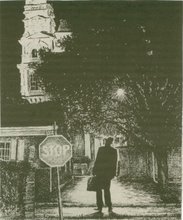A Swift Passage, by Barbara Henning, Niantic, CT: Quale Press, 2013, $16
“There
is simply ourselves,” Charles Olson insisted in his 1965 Berkeley Poetry
Conference lecture, “and where we are has a particularity which we’d better use
because that’s about all we got… the literal essence and exactitude of your
own. I mean the streets you live on, or
the clothes you wear, or the color of your own hair.” (Causal Mythology, Four Seasons Foundation, 1969)
Barbara
Henning cites Olson as one of her inspirations. Therefore
it’s understandable that A Swift Passage,
her important new collection of poems and stories, would appear to enact the psychogeography proposed by Olson in his Berkeley
lecture:
“Peddling along,
I look down at my blue socks, one higher than the other. No city money for street repair this year,
but instead an incredible pattern of intersecting cracks and potholes.” (“Third
Street Tucson”)
“All
I need is one little room and a mat to sleep on. A good blanket. Water, we need some
water. And a little burner, a cup and a
plate. And some vegetables and
fruits. That’s all, Barbara. That’s all.”
(“Little Green Rooms”)
“And
here I am this morning on my knees in Jean’s flower garden in St. Clair Shores.
Michigan, scraping old paint off a cement swordfish and then painting it white
up to the snout where no water shoots out any more.” (“Lake St. Claire”)
“An
old woman crosses Eleventh Street, pushing a walker on wheels. Shrunken with
her frame bent forward, wearing little heels and a tweedy old coat—she stops
for a moment and lifts up her foot to kick some stone or dirt off the
wheel.” (“Second Avenue”)
“Bike
over to Chinatown to buy a wedding gift.
Downhill Avenue A to Third Street, uphill to Broadway and then downtown
downhill, the clouds hiding the sun, sometimes for many days.” (“Single on a Stem”)
“In
a café on First Avenue, Julie Patton and I eat gazpacho and then we ramble
through the park, standing in the dark under an ancient elm tree.” (“Humidity”)
“On
highway 23, heading north toward the Upper Peninsula of Michigan. It’s raining beautiful rain, pine trees,
deciduous, now pine, now foggy, and the little trailers and trucks leave a
trail behind them of smoke and water, the wipers going back and forth, pretty
continual the rain today, but a lightness in the northern sky.” (“Off Highway 23”)
“Allen’s
ashes are buried somewhere on the back slope of Nelson Creek, a tributary from
the Chocolay River. After a couple of
big storms with trees collapsing, the creek now has two branches divide disconnect
bifurcate.” (“Nelson Creek”)
“After
you pass Orchard Restaurant, turn right on Sandling. Straight up you’ll see a clearing and an old
brown broken-down barn.” (“Turn Right”)
I
quote from poems and short stories, which Henning says comprise “a blend of
fiction and autobiography,” some originating as “vignettes” from her journals,
excerpted and woven together in a process she calls “sequential quilting.” Her inspired collection also includes two
full length stories, “Hegira,” and “The Dinner,” which expand on themes
explored in the poems and shorter prose, while maintaining the same
autobiographical tensions that underpin her incandescent road novel, Thirty Miles to Rosebud (BlazeVOX,
2009).. The specificity of the places described, the encounters and insights
experienced in them, the sense both of motion through the country, from the
Lower East Side of New York to Michigan’s Upper Peninsula, from Tucson, Arizona
to Mexico City (“Sometimes it seems as if you are caught in the drift—And yet
everything every act
is impregnated with
possibility fragility runaround
sidestepping”), and meditative stasis (“It makes me want to crawl inside
my tent and just lie still and listen to the rain”), combine to give the book
its verbal and contextual richness.
In
her concluding “Notes on This Collection” Henning speaks of traveling “through
love and space,” and this is perhaps the clearest and most accurate
articulation of her purpose in having composed and collected these shimmering pieces.
The love is not only of places intensely
inhabited or thoughtfully traversed, it is of people—former partners and
lovers, her children, friends kept and lost— longingly remembered and vividly
described, yet without sentimentality.
Rather, the emotion is a function of the specificity. Places for Henning are not merely names on
roadmaps but histories which enfold us in them: “The water on earth and in our animal human
bodies plants lands air is the same water
that was here when the dinosaurs were lumbering water
sound earth ether
moving reassembling to destroy
re story call forth again om nama shivaya…”
At
bottom, what Henning suggests is an ecology: “Water flows from the Colorado
River to the Gulf of California and Tucson gardens overflow downpour
perennial springs irrigation tree-lined
rivulet monsoon riverbed
barren run dry Stein says that the work of man is not in
harmony with the landscape, it opposes it and it is just that that is the basis
of cubism.” And this stunning book, in
its form and content, is itself a reflection and a demonstration of that
cubism, while also reminding us of Olson’s further insistence in his Berkeley lecture
that the earth remains “the geography of our being.”
(This review appeared in House Organ, Number 87, Summer 2014)



No comments:
Post a Comment